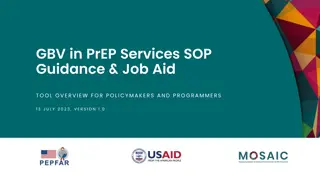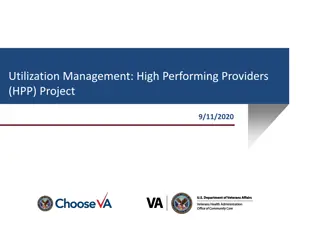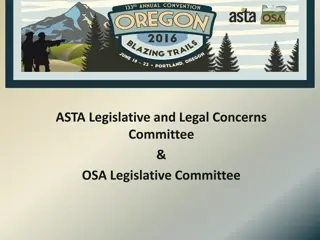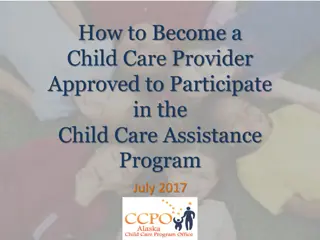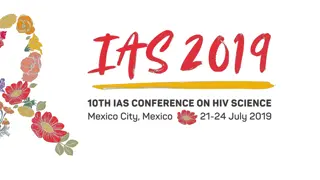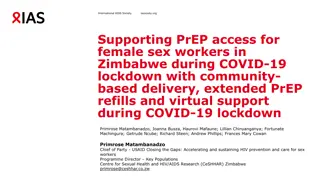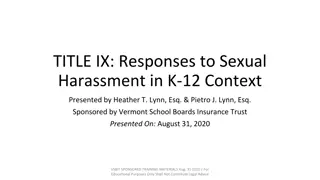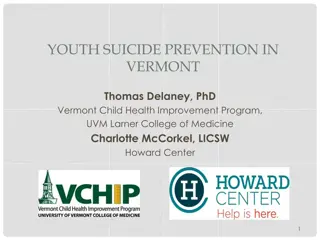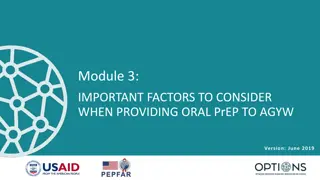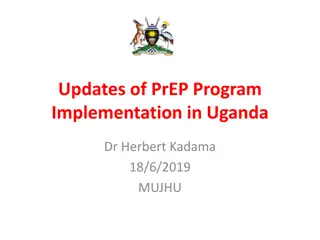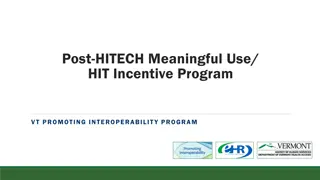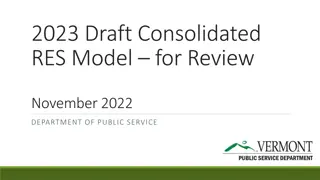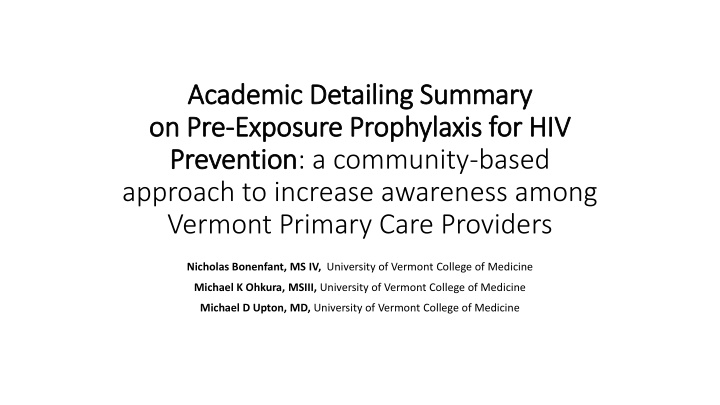
Community-Based Approach to Increase PrEP Awareness Among Vermont Providers
Vermont faces limited awareness of pre-exposure prophylaxis (PrEP) for HIV prevention, despite FDA approval and proven efficacy. The study explores PrEP effectiveness, target populations beyond MSM, and the importance of daily adherence in reducing HIV transmission risk.
Download Presentation

Please find below an Image/Link to download the presentation.
The content on the website is provided AS IS for your information and personal use only. It may not be sold, licensed, or shared on other websites without obtaining consent from the author. If you encounter any issues during the download, it is possible that the publisher has removed the file from their server.
You are allowed to download the files provided on this website for personal or commercial use, subject to the condition that they are used lawfully. All files are the property of their respective owners.
The content on the website is provided AS IS for your information and personal use only. It may not be sold, licensed, or shared on other websites without obtaining consent from the author.
E N D
Presentation Transcript
Academic Detailing Summary Academic Detailing Summary on Pre on Pre- -Exposure Prophylaxis for HIV Exposure Prophylaxis for HIV Prevention Prevention: a community-based approach to increase awareness among Vermont Primary Care Providers Nicholas Bonenfant, MS IV, University of Vermont College of Medicine Michael K Ohkura, MSIII, University of Vermont College of Medicine Michael D Upton, MD, University of Vermont College of Medicine
Whats the problem like in Vermont? Over the past 10 years, new diagnoses range from 11-19 per year VT Dept. of Health: 670 HIV+ Vermonters Estimated to be closer to 800 HIV+ individuals when including those who are likely unaware of their status. 56% fall into the MSM population. In 2012, a pre-exposure prophylaxis (PrEP) medication, Truvada, was FDA approved for HIV prevention. Despite this and clear evidence of its prophylactic effect from multiple clinical trials, community and provider awareness remains limited in Vermont with a most recent estimate of only 9 providers, not including Planned Parenthood offices, who have actively prescribed PrEP.
What is PrEP? What is PrEP? Does Does PrEP PrEP actually work? actually work? Pre-exposure prophylaxis FDA approved in 2012 for HIV prevention in HIV-negative individuals Truvada (combination of two medications) Emtricitabine (Emtriva) and tenofovir (Viread) Nucleoside reverse transcriptase inhibitors Preventing HIV viral enzyme from making more copies of itself The studies to date are very promising (iPrEx study) 2,500 HIV-seronegative men & transgender women who have sex with men. NEJM; Pre-exposure prophylaxis for HIV prevention in MSM, Jan. 2011 Participants who took Truvada daily, estimated protection was 99% Participants who took it 4 days per week, estimated protection was 96% Participants who took it 2 days per week, estimated protection was 76% Detectable blood levels strongly correlated with the prophylactic effect
What about other at risk populations besides MSM? Who else would benefit from PrEP? Heterosexual men and women in serodiscordant relationships Partners PrEP Study Truvada vs. placebo in 4,500 participants in Kenya & Uganda Reduction of new infections by 73% (of those assigned to take Truvada) When the researchers measured blood levels of the medication, the reduction rate was 90% What does this mean? IV Drug Users Bangkok Tenofovir Study (BTS) Truvada vs. placebo in 2,400 participants who reported intravenous drug use during the previous year Overall, Truvada demonstrated reduction in risk of HIV infection by 49% But, again, when researchers looked at the participants who were directly observed taking Truvada daily, they found that protection increased to 74% Questions remain about Truvada s effect on parenteral HIV acquisition Adherence to taking this medication daily matters! N Engl J Med 2012; 367:399-410 August 2, 2012 DOI: 10.1056/NEJMoa1108524
Most Recent Research Kaiser Permanente SF Medical Center Study (September 2015) N=657 individuals started PrEP, 99% MSM population No new HIV diagnoses At Risk Populations The studies to date have demonstrated Truvada s potential in helping reduce the rate of HIV infection in the following at risk populations 74% reported no change in number of sexual partners 15% decreased the number of partners; 11% increased 41% reported decreased condom use; 56% unchanged 30% diagnosed with an STI in first 6-months, 50% in 12-months Chlamydia (33%), gonorrhea (28%), syphilis (5.5%) Men who have sex with men (MSM) Heterosexual serodiscordant (magnetic) couples Intravenous drug users (IVDU) Important take away Compliance with this medication is crucial to its prophylactic effect! Limitations: no control group, study population
The Lancet editorial: identification of high risk people is less helpful than leaving home, becoming an adult, coming out as a MSM, immigrating to identification of high risk moments and the situations that cause them: a new city, or ending a relationship
For full CDC PrEP Quick Factsheet, please see: https://www.cdc.gov/nchhstp/newsroom/docs/factsheets/prep-factsheet-508.pdf
Lab Tests and Evaluation 1) HIV antibody test Confirm HIV (-) status before initiating, and every 3 months (ideally within the week before refilling Rx) Accomplish via serum HIV ELISA or rapid POC FDA approved fingerstick blood test Do NOT use oral rapid tests in PrEP monitoring due to less sensitivity Do NOT accept self-reported results or documented anonymous results If positive HIV antibody: follow normal procedure for confirmatory testing If acute infection suspected, must defer to HIV RNA test for acute exposure 2) Renal Function Obtain serum Cr and eCrCl Minimum eCrCl of 60ml/min Among HIV-infected persons prescribed Truvada-containing regimens, decreases in renal function (eCrCl) have been documented Occasional cases of acute renal failure 3) Test for active HVB/HCV infection MSM and IVDU at increased risk Tenofovir has activity against HBV, thus if pt stops med, reactivation of HBV potential hepatic damage
What are the side effects of PrEP? Importance of the Sexual History and site-specific STD testing Quarterly visits provide regular opportunities with obtaining a sexual history Perform STI testing at least every 6 months, if not quarterly Importance of site-specific testing (2010 CDC STD guidelines for MSM screening) Urethral G/C swab if insertive intercourse in past year Rectal G/C swab if receptive intercourse in past year Pharyngeal G/C swab if receptive oral sex in past year Most people taking Truvada report no side effects. Those that are reported are generally mild Nausea (9%), headaches (5%), weight loss (2%) and increased serum creatinine (0.3%) As with many medications, there is a risk of serious side effects: Lactic acidosis, hepatic dysfunction, worsening of hepatitis B infection Recommended labs every 3 months to monitor for: HIV status, other STI s, LFT s, and serum BUN/Cr Anal Paps? NY State Dept. of Health recommends for HIV+ patients CDC/USPSTF/ACS do not recommend Recommendations? HIV- patients = baseline, q2-3 years
http://www.sfcityclinic.org/providers http://fenwayhealth.org/
What can be done to overcome barriers? Road to Zero Campaign whose goal is to achieve zero new HIV infections in Vermont by 2020 Average of 20 new diagnoses per year (over the past 5 years) Vermont is in striking distance of becoming the first state ever to achieve this goal VT Cares Provider education about PrEP Indications (at risk populations) Provider role in monitoring patients on PrEP Cost concerns Truvada is covered by Vermont Medicaid and Blue Cross-Blue Shield Gilead Sciences (manufacturer of Truvada) provides a Copay Card which covers full cost of medication: https://www.gileadadvancingaccess.com/copay-coupon- card Patient awareness, education, and counseling VT Cares: counseling services currently, plans to expand PrEP is front and center Major limitation? Currently only 9 providers actively prescribing PrEP Insufficient to fully demonstrate the public health impact PrEP can have Peter Jacobsen, Executive Director of VT Cares
References Baeten et al. New England Journal of Medicine, Antiretroviral prophylaxis for HIV prevention in heterosexual men and women, 2012; 367: 399-410. Aug 2 2012. CDC: HIV/AIDS, 2015. http://www.cdc.gov/hiv/ CDC: Pre-exposure prophylaxis, 2015. http://www.cdc.gov/hiv/risk/prep/index.html CDC: Clinical practice guidelines, 2014. http://www.cdc.gov/hiv/pdf/prepguidelines2014.pdf CDC: High-Impact HIV Prevention guidelines, https://effectiveinterventions.cdc.gov/docs/default-source/general-docs/12-0209_HIP_CDCs_Approach_red_booklet.pdf?sfvrsn=0 Choopanya et al. The Lancet, Antiretroviral prophylaxis for HIV infection in injecting drug users in Bangkok, Thailand (the Bangkok Tenofovir study): a randomized, double-blind, placebo-controlled phase 3 trial. Online pub, June 13 2013. http://dx.doi.org/10.1016/S0140-6736(13)61127-7 Flanagan et al. Facilitators and barriers to prescribing Pre Exposure Prophylaxis (PrEP) for the prevention of HIV. UVM College of Medicine. Golden, Matthew. Anal Cancer: Should Screening be Routine? Northwest AIDS Education and Training Center. http://depts.washington.edu/nwaetc/presentations/uploads/54/anal_cancer_should_screening_be_routine.pdf Grant et al. New England Journal of Medicine, Preexposure chemoprophylaxis for HIV prevention in MSM, 2010; 363: 2587-2599. Dec 30 2010. Kaiser Family Foundation, State Health Facts. Medicaid Enrollment Coverage on HIV/AIDS. http://kff.org/hivaids/state-indicator/enrollment-spending-on-hiv/ Kaiser Family Foundation, US Federal Funding HIV/AIDS. http://kff.org/global-health-policy/fact-sheet/u-s-federal-funding-for-hivaids-the-presidents-fy-2016-budget-request/ McNeail, Donald. New York Times. Advocating Pill, US Signals Shift to Prevent AIDS. May 14 2014. San Francisco AIDS Foundation, PrEP Facts. http://www.prepfacts.org Velk et al. No New HIV Infection With Increasing Use of HIV Preexposure Prophylaxis in a Clinical Practice Setting, Clinical Infectious Disease, 2015: 61(10): 1601-3 Vermont Cares, 2015. http://www.vtcares.org

